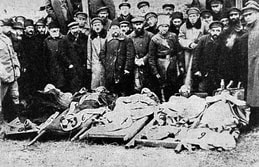 This month marks the centenary of one of the worst pogroms in history, an attempt at genocide against the Jews of the town of Proskurov in present-day Ukraine. In February 1919, local Cossack leader Ataman Semosenko assumed command of the nationalist forces in the region and called for the elimination of the Jews in order to “save Ukraine”. As the town’s Jews, who numbered around 25,000, prepared to celebrate the Sabbath, hoards of Cossacks descended on the town and began attacking Jews in the streets and in their homes with knives, swords, bayonets and even hand grenades. The following are accounts from survivors: “They [the Cossacks] were divided into groups of five to 15 men and swarmed into the streets which were inhabited by Jews. Entering the homes, they drew their swords and began to cut the inhabitants without regard to sex or age… Jews were dragged out of cellars and lofts and murdered.” Entire families were slain. One survivor, a nurse by the name of Chaya Greenberg, later testified: “The young girls – repeatedly stabbed. The two-month old baby – hands lacerated. The five-year old – pierced by spears. The elderly man – thrown out of a window by his beard. The 13-year old – deaf because of his wounds. His brother – 11 wounds in his stomach, left for dead next to his slain mother. The paralysed son of a rabbi – murdered in his bed. The two young children – cast alive into a fire….I will never forget the reddened snow from sleds filled with the hacked bodies going to a common pit in the cemetery.” Some of the victims were forced to dig their own graves. Around 1,600 Jews are estimated to have been killed, although some put the death toll higher. Many more sustained terrible injuries and were crippled for life having had limbs severed. The Jewish hospital and makeshift medical stations were filled with the wounded as relatives and local peasants brought in the victims. Most were buried in mass graves. Some gentiles risked their lives to protect their fellow townsfolk, in a community that generally experienced good relations between those of different faiths. A doctor named Polozov helped many wounded Jewish children he found in the street. He hid more than 20 Jews in his own home. Priests were murdered as they attempted to halt the pogrom. The Proskurov pogrom was just one of hundreds that took place in Ukraine in 1919 during Russia’s chaotic and bloody civil war that followed the Bolshevik Revolution. The pogroms followed the withdrawal of German troops after World War I, when Communists, Ukrainian nationalists, the anti-Bolshevik White Army and numerous smaller factions vied for control, all of them engaging in anti-Semitic violence to a greater or lesser degree. The words of historian Orest Subtelny in his mammoth Ukraine: A History are worth repeating, “In 1919, total chaos engulfed Ukraine. Indeed, in the modern history of Europe no country experienced such complete anarchy, bitter civil strife, and total collapse of authority as did Ukraine at this time”. My own ancestral village of Pavoloch, where like Proskurov relations between Jews and the rest of the community were generally amicable, suffered wave after wave of attack by different groups of fighters, who my grandmother referred to collectively as ‘banda’. The most vicious was the White Army under General Anton Denikin. The following is an extract from A Forgotten Land describing just one of many, many horrors that my family suffered in Pavoloch in 1919: “The Whites weren’t like the anarchists who burst in and began smashing the furniture to pieces. They had brains and intuition that they used to figure out just where their victims might be hiding money or jewellery or hoarding food. The soldiers sniffed around like dogs, tapping at walls and floor boards, listening for a hollow echo that might indicate a hiding place. “‘Money! Give us your money, old man!’ the first giant demanded in Russian, prodding Zayde [Grandpa] with his bayonet. “Zayde’s carefully learnt Russian seemed to desert him and he mumbled something incomprehensible, his eyes fixed on the scuffed leather boots of his interrogator. “While his companions continued to search the house, kicking down the door to the warehouse, the leader of the group dealt my grandfather a swift blow with his rifle butt and watched poor Zayde crumple to the floor like a rag doll. Then he kicked him in the stomach with his huge leather boots until Zayde curled into a ball on the hard kitchen floor as pitiful as a tiny child. Again and again he beat him with his gun and kicked him. “By that time the other four soldiers had returned. Zayde wasn’t a big man so it didn’t take them long to hustle him onto the table, pull his scuffed leather belt from around his waist and force his head into the noose they made with it. Then they hanged him from the hook on the kitchen ceiling that we used for drying meat.” My great-great grandfather survived the ordeal, but only because the belt that was used to hang him snapped in two, dropping him to the floor with a great thump. But he was never the same again.
0 Comments
Leave a Reply. |
Keeping stories aliveThis blog aims to discuss historical events relating to the Jewish communities of Ukraine, and of Eastern Europe more widely. As a storyteller, I hope to keep alive stories of the past and remember those who told or experienced them. Like so many others, I am deeply troubled by the war in Ukraine and for the foreseeable future, most articles published here will focus on the war, with an emphasis on parallels with other tumultuous periods in Ukraine's tragic history. Archives
March 2024
Categories
All
|
 RSS Feed
RSS Feed
